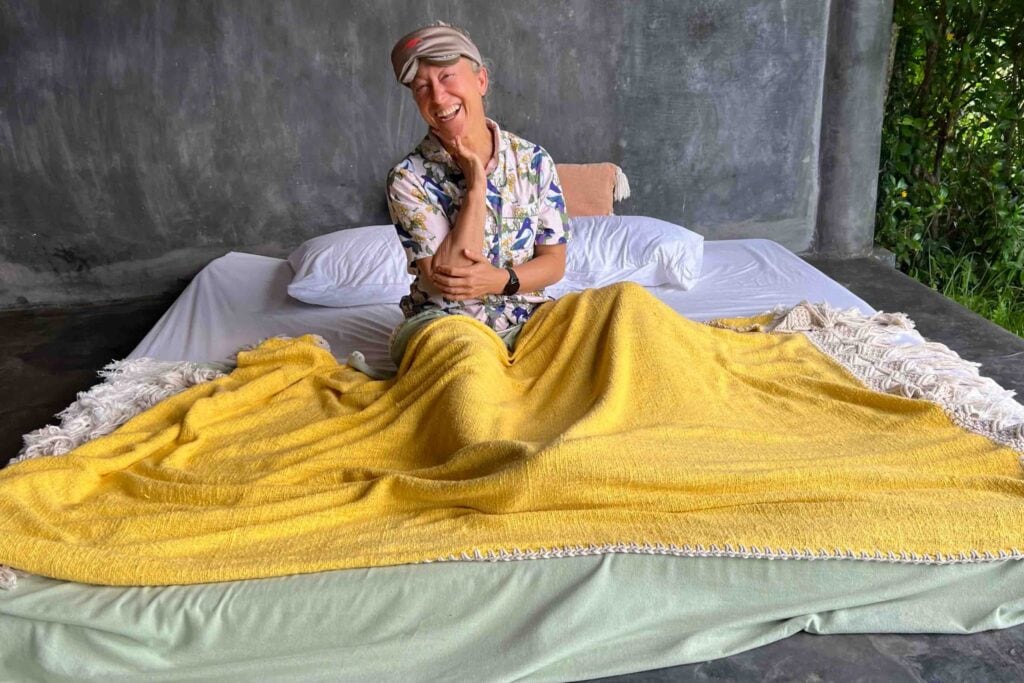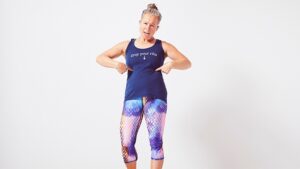I always get lots of questions about floor sleeping. It’s one of those movement things that seems super strange at first. Until you realize that it is actually a really easy & inexpensive way to add more movement to your life – without taking any extra time. My favourite! So here’s the deal.

Question #1: Why The !*!&^#%% Would Anyone Want To Sleep On The Floor?
There are lots of reasons that floor sleeping is awesome.
First, getting up and down from the floor gives you a lot more movement than getting into a bed that’s raised. Sure, it’s only going to be a few times a day, but when that adds up over years, it’s a whole lot of movement variety and muscle use! When you limit the ranges you go into by sitting in chairs and sleeping on raised beds, your muscles adapt by getting shorter and weaker. Not cool.
Second, sleeping on harder surfaces creates different loading for your body. Lots of people find that this helps their bodies naturally adjust into better alignment with fewer aches and pains. My partner, my colleagues and I have variously reported less stiffness first thing in the morning, less neck and back pain, and better breathing and rib mobility.
Third, it makes you really versatile. When I travel, I can sleep anywhere and be comfortable, instead of tossing and turning each time I sleep in a new bed. Same thing with camping.
Fourth, if you sleep with someone who rolls over a lot at night, a floor set-up can be your best friend. Unlike a mattress, your floor will not jiggle when they toss and turn! Better sleep for all!
Question #2: What’s The Best Way To Start Floor Sleeping?
There’s no clear rule here – some people just start sleeping on the floor – but I believe in making all transitions slowly and carefully. Here’s what we did, to give you an example.
We started just by switching sides of the bed regularly. Next, we got rid of our bed frame and just slept with our mattress on the floor for about 9 months. We didn’t actually have a plan to get rid of the mattress, but we happened to plan a 10-day camping trip last summer. After 10 days of sleeping on a Thermarest on top of rocks and roots, we figured we were ready to try it at home.
We just took our mattress to the garage and set up our camping Thermarests in our bedroom. It took about a week before we were entirely comfortable. That worked well for a few months but…it turns out Thermarests weren’t made for constant use and we basically destroyed them. So we took the plunge and invested in our current solution – two organic cotton shiatsu mats that we place on top of yoga mats. We love them!
All in all, it took us about a year to transition, which made it very, very easy. I’d recommend that you start by making a small change (like switching your side of the bed) and see how your body reacts. Then after a few weeks you can try another incremental change, and so on and so forth. You could also buy a very firm mattress and a soft topper and then eventually remove the topper.
Alternatively, you could take a more sudden approach. My mother just came to visit and she slept on the floor with no transition at all. Apparently though she felt just fine. She is obviously awesome. She also travels a lot and stays with friends, so I suspect that she’s used to lots of different sleeping surfaces. I wouldn’t recommend that approach, but clearly it can work for the right person.
Question #3: So What Do I Need To Know About Creating My Floor-Sleeping Set Up?
Air circulation is really important! I’ve heard about lots of people who got really into floor sleeping, only to find that they accidentally created a mould issue in their bedroom. NOT cool.
We roll up our mats each morning and place them in the sun when we can.
Other people find or build low slatted platforms to allow airflow, or use a tatami. Especially if you live in a damp climate, this is really huge! It would be a sad thing to buy a beautiful floor sleeping pad and then have it get mouldy and gross.
Another consideration is storage – having a low slatted bed can be super handy if you don’t have alternative places to keep your stuff.
Question #4: Can You Recommend Some Floor Sleeping Mats?
I certainly can! With the (major) caveat that I haven’t tried most of them myself – only the first one.
We bought these organic cotton mats (the larger size) about a year ago now and they are still going strong although they’ve been squashed down a bit. I love that they’re organic and made in (and shipped from) Canada.
You could try a wool mattress topper layered on top of a tatami or a thin foam base.
There’s also a Shikifuton, which is a bedding set that consists of a structureless mattress (a shikibuton) and a duvet (a kafefuton). This set is designed to be used on top of a Tatami mat, similar to the previous option.
These bed felts are absolutely gorgeous and are the top of my wish list for when we need to replace our mats.
Wool mattresses are a lovely option as well.
Just a regular futon floor mattress would likely work well, too. If you decide to go this route, you can pick all-cotton, which is likely to squish down over time. Or you could go with a mix of foam and cotton, which I feel is more likely to retain its thickness for longer.
Question #5: My Husband/Wife/Significant Other Will Divorce Me If I Try To Get Rid Of The Bed. What Should I Do?
This is always such a challenge. If you and your spouse aren’t on the same page about movement, transitioning is much more challenging. Some ideas are:
1️⃣ You can just start sleeping on the floor without them. This works really well for some people but it’s not everyone’s favorite.
2️⃣ Get a firm/thin futon and a half-sized soft topper for the spouse who wants more squish.
3️⃣ Keep your regular bed, but put a half-sized piece of plywood between the mattress and the box-spring on your side.
4️⃣ Be patient – many people find that their spouses start getting more into movement over time as long as you don’t push them into it at the beginning. Changing beds is a big ask for many people, so start with a standing workstation or minimal shoes instead.
I hope these tips are useful for you!
If you’re looking for more lifestyle, wellness and movement tips & hacks, make sure to sign up for my weekly newsletter!






